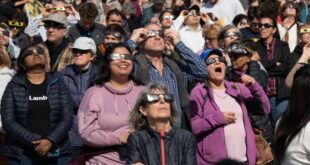Odysseus lander touched down on the lunar south pole after a nail-biting few days.

The first private spacecraft to softly land on the moon carries a Canadian instrument that will test the possibility of building an observatory at the Lunar south pole.
The phone booth-sized lander by Intuitive Machines, named Odysseus, launched on Feb. 15 and touched down on Thursday near a small impact crater about 300 kilometers from the moon’s south pole.
It was a stressful event with navigation and communication issues, but 15 nail-biting minutes after it landed, mission control confirmed that they were receiving a faint but steady signal from the spacecraft.
“What we can confirm, without a doubt, is our equipment is on the surface of the moon and we are transmitting,” said Intuitive Machines mission director Tim Crain.
“Houston, Odysseus has found his new home.”
Odysseus carries a suite of twelve instruments, six of which are from NASA and the rest from commercial companies.
The Canadian component, built by space systems company Canadensys, is a miniaturized dual camera with one wide-field lens and one telephoto lens, that will point upwards to take images of the Milky Way Galaxy, as well as other astronomical objects including the Earth.
This is a proof of concept study to determine whether the south pole of the moon is a good place for an astronomical observatory. It will also be a test of whether images from space can be broadcast back to Earth, which is very low on the horizon from the lunar polar regions.
The camera is named ILO-X after the International Lunar Observatory Association, a non-profit enterprise incorporated in Hawaii that promotes the concept of building astronomical observatories on the moon.

Astronomers would be delighted to have an observatory on the moon because it provides the clear, airless view of the universe that you get from a space telescope, with the added benefit of being on land. That means there are no size limits, and in astronomy, size matters.
While the Hubble and James Webb space telescopes have returned astounding images, those instruments were limited by the space available in the nose cone of a rocket. In fact, Webb had to be folded up to take the ride to space.
A telescope on the moon could be built much larger and provide even finer details of the universe. An observatory on the far side of the moon would be shielded from noisy radio chatter bouncing around Earth.

High-tech industries across the country are building precision scientific instruments and sending them to space. And Canadian scientists have been doing this from the very start of the space race, with our first satellite Alouette One launched in 1962. That made us the third country in space after the Soviet Union and America.
Canada is best known for its astronauts and robotic Canadarm but we have also built satellites such as the Radarsat constellation. We also flew instruments to Mars, including one that measures cloud cover and another that analyzes the chemistry of rocks. Canadian instruments are also part of the James Webb Space Telescope.
We are a space-faring country, but we don’t make a lot of noise about it. Rather than build big expensive rockets, we join with other countries and go along for the ride — a much cheaper way to explore space. While our instruments may be small, they still make significant contributions.
Perhaps our little camera on this mission could be a small step that leads to a giant leap for astronomy.
ABOUT THE AUTHOR
Bob McDonald is the host of CBC Radio’s award-winning weekly science program, Quirks & Quarks. He is also a science commentator for CBC News Network and CBC TV’s The National. He has received 12 honorary degrees and is an Officer of the Order of Canada.
*****
Credit belongs to : www.cbc.ca
 Atin Ito First Filipino Community Newspaper in Ontario
Atin Ito First Filipino Community Newspaper in Ontario







